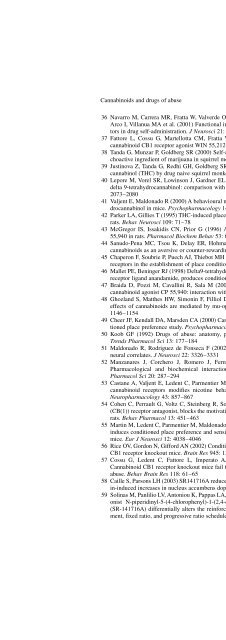3. Umbruch 4.4..2005 - Online Pot
3. Umbruch 4.4..2005 - Online Pot
3. Umbruch 4.4..2005 - Online Pot
You also want an ePaper? Increase the reach of your titles
YUMPU automatically turns print PDFs into web optimized ePapers that Google loves.
Cannabinoids and drugs of abuse 217<br />
36 Navarro M, Carrera MR, Fratta W, Valverde O, Cossu G, Fattore L, Chowen JA, Gomez R, del<br />
Arco I, Villanua MA et al. (2001) Functional interaction between opioid and cannabinoid receptors<br />
in drug self-administration. J Neurosci 21: 5344–5350<br />
37 Fattore L, Cossu G, Martellotta CM, Fratta W (2001) Intravenous self-administration of the<br />
cannabinoid CB1 receptor agonist WIN 55,212-2 in rats. Psychopharmacology 156: 410–416<br />
38 Tanda G, Munzar P, Goldberg SR (2000) Self-administration behavior is maintained by the psychoactive<br />
ingredient of marijuana in squirrel monkeys. Nat Neurosci 3: 1073–1074<br />
39 Justinova Z, Tanda G, Redhi GH, Goldberg SR (2003) Self-administration of delta9-tetrahydrocannabinol<br />
(THC) by drug naive squirrel monkeys. Psychopharmacology 169: 135–140<br />
40 Lepore M, Vorel SR, Lowinson J, Gardner EL (1995) Conditioned place preference induced by<br />
delta 9-tetrahydrocannabinol: comparison with cocaine, morphine, and food reward. Life Sci 56:<br />
2073–2080<br />
41 Valjent E, Maldonado R (2000) A behavioural model to reveal place preference to delta 9-tetrahydrocannabinol<br />
in mice. Psychopharmacology 147: 436–438<br />
42 Parker LA, Gillies T (1995) THC-induced place and taste aversions in Lewis and Sprague-Dawley<br />
rats. Behav Neurosci 109: 71–78<br />
43 McGregor IS, Issakidis CN, Prior G (1996) Aversive effects of the synthetic cannabinoid CP<br />
55,940 in rats. Pharmacol Biochem Behav 53: 657–664<br />
44 Sanudo-Pena MC, Tsou K, Delay ER, Hohman AG, Force M, Walker JM (1997) Endogenous<br />
cannabinoids as an aversive or counter-rewarding system in the rat. Neurosci Lett 223: 125–128<br />
45 Chaperon F, Soubrie P, Puech AJ, Thiebot MH (1998) Involvement of central cannabinoid (CB1)<br />
receptors in the establishment of place conditioning in rats. Psychopharmacology 135: 324–332<br />
46 Mallet PE, Beninger RJ (1998) Delta9-tetrahydrocannabinol, but not the endogenous cannabinoid<br />
receptor ligand anandamide, produces conditioned place avoidance. Life Sci 62: 2431–2439<br />
47 Braida D, Pozzi M, Cavallini R, Sala M (2001) Conditioned place preference induced by the<br />
cannabinoid agonist CP 55,940: interaction with the opioid system. Neuroscience 104: 923–926<br />
48 Ghozland S, Matthes HW, Simonin F, Filliol D, Kieffer BL, Maldonado R (2002) Motivational<br />
effects of cannabinoids are mediated by mu-opioid and kappa-opioid receptors. J Neurosci 22:<br />
1146–1154<br />
49 Cheer JF, Kendall DA, Marsden CA (2000) Cannabinoid receptors and reward in the rat: a conditioned<br />
place preference study. Psychopharmacology 151: 25–30<br />
50 Koob GF (1992) Drugs of abuse: anatomy, pharmacology and function of reward pathways.<br />
Trends Pharmacol Sci 13: 177–184<br />
51 Maldonado R, Rodriguez de Fonseca F (2002) Cannabinoid addiction: behavioral models and<br />
neural correlates. J Neurosci 22: 3326–3331<br />
52 Manzanares J, Corchero J, Romero J, Fernandez-Ruiz JJ, Ramos JA, Fuentes JA (1999)<br />
Pharmacological and biochemical interactions between opioids and cannabinoids. Trends<br />
Pharmacol Sci 20: 287–294<br />
53 Castane A, Valjent E, Ledent C, Parmentier M, Maldonado R, Valverde O (2002) Lack of CB1<br />
cannabinoid receptors modifies nicotine behavioural responses, but not nicotine abstinence.<br />
Neuropharmacology 43: 857–867<br />
54 Cohen C, Perrault G, Voltz C, Steinberg R, Soubrie P (2002) SR141716, a central cannabinoid<br />
(CB(1)) receptor antagonist, blocks the motivational and dopamine-releasing effects of nicotine in<br />
rats. Behav Pharmacol 13: 451–463<br />
55 Martin M, Ledent C, Parmentier M, Maldonado R, Valverde O (2000) Cocaine, but not morphine,<br />
induces conditioned place preference and sensitization to locomotor responses in CB1 knockout<br />
mice. Eur J Neurosci 12: 4038–4046<br />
56 Rice OV, Gordon N, Gifford AN (2002) Conditioned place preference to morphine in cannabinoid<br />
CB1 receptor knockout mice. Brain Res 945: 135–138<br />
57 Cossu G, Ledent C, Fattore L, Imperato A, Bohme GA, Parmentier M, Fratta W (2001)<br />
Cannabinoid CB1 receptor knockout mice fail to self-administer morphine but not other drugs of<br />
abuse. Behav Brain Res 118: 61–65<br />
58 Caille S, Parsons LH (2003) SR141716A reduces the reinforcing properties of heroin but not heroin-induced<br />
increases in nucleus accumbens dopamine in rats. Eur J Neurosci 18: 3145–3149<br />
59 Solinas M, Panlilio LV, Antoniou K, Pappas LA, Goldberg SR (2003) The cannabinoid CB1 antagonist<br />
N-piperidinyl-5-(4-chlorophenyl)-1-(2,4-dichlorophenyl)-4-methylpyrazole-3-carboxamide<br />
(SR-141716A) differentially alters the reinforcing effects of heroin under continuous reinforcement,<br />
fixed ratio, and progressive ratio schedules of drug self-administration in rats. J Pharmacol







